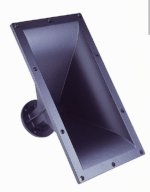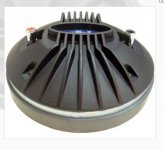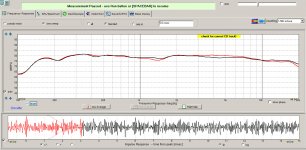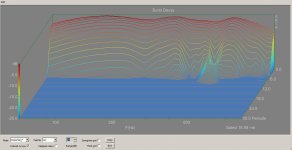Ok, time has come. Firstly, why bother? Simple, I'm sick of reading misguided unsubstantiated nonsense from "gurus" that many appear to hold in high standing, hanging on to every bit of subjectivist nonsense they spew out...
Let's be clear, no loudspeaker is perfect, no audio component is perfect, and sorry to burst bubbles but brand name is meaningless and the amount you pay has no relation to performance. Science doesn't work that way.
If you want credentials, because I am not one of the "designer gods", I started my interest in 1972, was involved in live audio with an EV horn based PA system (EV Sentry IV's, SM500 horns, etc)..built my own VOTT's. At the other end of the scale, and domestically, had stacked QUAD electrostatics, my own design 2 x 15 sub and Kelly Ribbon tweeters...an active system (TEAC) in 1975!! Taking a leap to the future(!), one of the first to design studio monitors around DSP (BSS366) which were reviewed in the UK and put in the same class as ATC, PMC and Genelec. This design was innovative in that it had 18" drivers in a Linkwitz Transform bass and a 12" coaxial for mid and treble.
So when I approached this project I set some targets. Certain criteria had to be met for substantially good audio performance, and many seemed obvious and elementary.
Ideally I wanted a driver to cover a wide bandwidth to avoid the requirement for "tweeters"..limited compromises could be made here, putting any anomalies in response or "break up" above 10khz where there is little information may suffice. The majority of tweeters fail this test anyway unless their diaphragms are 19mm or less, and most seem content with that. Ribbons may avoid this problem, but they have other issues!
Response must be flat to "monitor" standards and +/-2dB throughout the bandwidth of interest seemed appropriate.
No point having a flat response just on axis so they must perform equally well on and off axis.
Distortion must be low, in particular odd harmonics.
No point having a "flat response" if it is made up of resonances..so, critically, the response must produce clean Burst Decay and Cumulative Spectral Response plots..these, as I'm sure you all know, reveal if there are any problems and how audible they will be. No loudspeaker is perfect, and I'll say again, no loudspeaker is perfect, but it is a case of how audible the anomalies are.
Right..that set the targets. How to go about achieving the result..(bored yet)..it took me a year of development so have some patience!
The loudspeaker is only part of a circuit of course (making cable arguements the total BS they are). The easier the load in terms of flat impedance and phase angle the more your amp will love you. You will note from the plot this design achieves 6 ohms throughout from DC (shown from 100Hz) to 20khz and a 0 deg phase angle. The amp is basically seeing a 6 ohm resister. Easy, and you wont need a "high end" BS amp to drive it..a cheap one will do ..or a load sensitive one. This is almost designed with Class A SET valve amps in mind. It is also designed for those that like passive crossovers..theory 6 ohm designs will work perfectly.
The particular loudspeaker chosen has a falling HF response from around 3.5Khz and this has been dealt with by implementing a "cutting" passive eq circuit, which you will note achieves the desired flat response. It also reduced the efficiency of the device to around 100dB/watt but that' ok...
Both circuits had to work together of course to provide the target result..flat impedance and flat response..
So you will probably have guessed its a horn and CD driver we are talking about!!
The choices here..I put constant directivity and even dispersion above beaming at HF, a performance characteristic of all other horn types. I eschewed the nonsense about all CD horns "shout" or have a characteristic sound (only in their even power delivery)..and put faith in Don Keele who's designs superseded all other horn types for good reasons.
As I said at the beginning, no loudspeaker is perfect, but it was my belief that ensuring maximum damping will ensure the diaphragm of the CD driver is optimally controlled. A decent sized throat will reduce distortion, which we know now is a heating effect..and a 3" diaphragm will push break up/resonance to above 10khz.
Cost although not a critical factor, was factored in..but science and a "different" approach to problems were more important than fancy high end arguments. The passive components are not cheap but one could argue they have to offer value given the outcomes which I think you will have to agree put many far more expensive alternatives to shame. The plots are unequivocal. (Of course the circuit boards are also "generic" and other drivers/horn combinations could have circuits derived for them..)
And now, the component choices. All passive components are Janzen, a mix of air cored and ferrite (for the RCL's) and 1% resisters. Unfancy (read no BS) Polyprop caps as one can see.
The horn is a P.audio 4525 90 x 40, 2" throat...AKA the Goldwood PB450 on your side of the pond. This was chosen as it is the only horn that performs like a CD horn but has the "dual" throat, a combination of slot and circular entrance.
The driver comes from a company I hold in very high regard having worked with many of their superb drivers..Beyma from Spain. The CP750ti is a well built 2" throat 75mm titanium diaphragm device with mylar suspension providing it with extension, damping and a design goal of theirs, an extended HF.
So there you have it, the plots don't lie. Consistent even coverage over a wide angle, low distortion, flat response and lack of resonances. And guess what, they sound great...well, they almost don't sound at all as colourations are reduced to a minimum....
Let's be clear, no loudspeaker is perfect, no audio component is perfect, and sorry to burst bubbles but brand name is meaningless and the amount you pay has no relation to performance. Science doesn't work that way.
If you want credentials, because I am not one of the "designer gods", I started my interest in 1972, was involved in live audio with an EV horn based PA system (EV Sentry IV's, SM500 horns, etc)..built my own VOTT's. At the other end of the scale, and domestically, had stacked QUAD electrostatics, my own design 2 x 15 sub and Kelly Ribbon tweeters...an active system (TEAC) in 1975!! Taking a leap to the future(!), one of the first to design studio monitors around DSP (BSS366) which were reviewed in the UK and put in the same class as ATC, PMC and Genelec. This design was innovative in that it had 18" drivers in a Linkwitz Transform bass and a 12" coaxial for mid and treble.
So when I approached this project I set some targets. Certain criteria had to be met for substantially good audio performance, and many seemed obvious and elementary.
Ideally I wanted a driver to cover a wide bandwidth to avoid the requirement for "tweeters"..limited compromises could be made here, putting any anomalies in response or "break up" above 10khz where there is little information may suffice. The majority of tweeters fail this test anyway unless their diaphragms are 19mm or less, and most seem content with that. Ribbons may avoid this problem, but they have other issues!
Response must be flat to "monitor" standards and +/-2dB throughout the bandwidth of interest seemed appropriate.
No point having a flat response just on axis so they must perform equally well on and off axis.
Distortion must be low, in particular odd harmonics.
No point having a "flat response" if it is made up of resonances..so, critically, the response must produce clean Burst Decay and Cumulative Spectral Response plots..these, as I'm sure you all know, reveal if there are any problems and how audible they will be. No loudspeaker is perfect, and I'll say again, no loudspeaker is perfect, but it is a case of how audible the anomalies are.
Right..that set the targets. How to go about achieving the result..(bored yet)..it took me a year of development so have some patience!
The loudspeaker is only part of a circuit of course (making cable arguements the total BS they are). The easier the load in terms of flat impedance and phase angle the more your amp will love you. You will note from the plot this design achieves 6 ohms throughout from DC (shown from 100Hz) to 20khz and a 0 deg phase angle. The amp is basically seeing a 6 ohm resister. Easy, and you wont need a "high end" BS amp to drive it..a cheap one will do ..or a load sensitive one. This is almost designed with Class A SET valve amps in mind. It is also designed for those that like passive crossovers..theory 6 ohm designs will work perfectly.
The particular loudspeaker chosen has a falling HF response from around 3.5Khz and this has been dealt with by implementing a "cutting" passive eq circuit, which you will note achieves the desired flat response. It also reduced the efficiency of the device to around 100dB/watt but that' ok...
Both circuits had to work together of course to provide the target result..flat impedance and flat response..
So you will probably have guessed its a horn and CD driver we are talking about!!
The choices here..I put constant directivity and even dispersion above beaming at HF, a performance characteristic of all other horn types. I eschewed the nonsense about all CD horns "shout" or have a characteristic sound (only in their even power delivery)..and put faith in Don Keele who's designs superseded all other horn types for good reasons.
As I said at the beginning, no loudspeaker is perfect, but it was my belief that ensuring maximum damping will ensure the diaphragm of the CD driver is optimally controlled. A decent sized throat will reduce distortion, which we know now is a heating effect..and a 3" diaphragm will push break up/resonance to above 10khz.
Cost although not a critical factor, was factored in..but science and a "different" approach to problems were more important than fancy high end arguments. The passive components are not cheap but one could argue they have to offer value given the outcomes which I think you will have to agree put many far more expensive alternatives to shame. The plots are unequivocal. (Of course the circuit boards are also "generic" and other drivers/horn combinations could have circuits derived for them..)
And now, the component choices. All passive components are Janzen, a mix of air cored and ferrite (for the RCL's) and 1% resisters. Unfancy (read no BS) Polyprop caps as one can see.
The horn is a P.audio 4525 90 x 40, 2" throat...AKA the Goldwood PB450 on your side of the pond. This was chosen as it is the only horn that performs like a CD horn but has the "dual" throat, a combination of slot and circular entrance.
The driver comes from a company I hold in very high regard having worked with many of their superb drivers..Beyma from Spain. The CP750ti is a well built 2" throat 75mm titanium diaphragm device with mylar suspension providing it with extension, damping and a design goal of theirs, an extended HF.
So there you have it, the plots don't lie. Consistent even coverage over a wide angle, low distortion, flat response and lack of resonances. And guess what, they sound great...well, they almost don't sound at all as colourations are reduced to a minimum....
Attachments
Last edited:
Digital filtering?? You can of course use passive, analogue or digital to crossover . The plots are without eq. But you'll have to trust them because 1) I'm in the UK 2) they're in my home system,
I can supply boards and the component details, but not for free of course. The circuits might become a product but I wanted to test the water. Frankly as it appears most aren't interested, I suspect it will remain a one off for "my listening pleasure"
I can supply boards and the component details, but not for free of course. The circuits might become a product but I wanted to test the water. Frankly as it appears most aren't interested, I suspect it will remain a one off for "my listening pleasure"
Just my opinion, but some reasons the reception may seem tepid in this particular forum:
1) High distortion in your results. They may be good for a horn, but compared to a well designed standard speaker they look high. The KEF LS50 Meta, for example, claims midband total harmonic distortion of 0.07% at 90 dB at 1 meter. Your initial post put 2nd harmonic at 1.5% with 100 dB at the driver.
2) Similar issue and example for the CSD result, as shown at the Stereophile link below. The KEF decays to background level by 0.6 msec through most of the treble range. Your presented result has significantly longer decay.
LS50 Meta | KEF
KEF LS50 Meta loudspeaker Measurements | Stereophile.com
Maybe there were issues with your measurement method or the benefits of the horn are significant for other reasons that make these shortcomings less important, but so far you haven't made a compelling case along these lines. Unless the product is a world-beater with obvious advantages, it's often up to the presenter to convincingly make the case for the benefits of their device. The guessing game format limited your ability to clearly make some of these points early or to draw clear distinctions between yours and other horns.
1) High distortion in your results. They may be good for a horn, but compared to a well designed standard speaker they look high. The KEF LS50 Meta, for example, claims midband total harmonic distortion of 0.07% at 90 dB at 1 meter. Your initial post put 2nd harmonic at 1.5% with 100 dB at the driver.
2) Similar issue and example for the CSD result, as shown at the Stereophile link below. The KEF decays to background level by 0.6 msec through most of the treble range. Your presented result has significantly longer decay.
LS50 Meta | KEF
KEF LS50 Meta loudspeaker Measurements | Stereophile.com
Maybe there were issues with your measurement method or the benefits of the horn are significant for other reasons that make these shortcomings less important, but so far you haven't made a compelling case along these lines. Unless the product is a world-beater with obvious advantages, it's often up to the presenter to convincingly make the case for the benefits of their device. The guessing game format limited your ability to clearly make some of these points early or to draw clear distinctions between yours and other horns.
you'll have to trust them because 1) I'm in the UK 2) they're in my home system
In this case i have no other choice !
The issue is that i have a system that i like, so no need to replace or add anything at this time.
For someone who is looking for some new speakers this is great news indeed.
I will pass this on as i do have friends, (unbelievable but true / not here on this forum) who are still looking...
Best regards,
Frank
Re: distortion. At 100dB at the mouth, the 2nd harmonic is 1.5%. As we know 2nd is only audible as added warmth...and this is total system distortion including valve equipment in circuit.. As is the .08% odd harmonic. At normal listening levels, Inaudible.
Is the Kef horn based...I doubt it. in which case it is scarcely relevant? The point of the horn is even power delivery...look again at the on and off axis plot. No tweeter can manage this and is probably at least 10dB less efficient. Ribbons might get close in horizontal but beam in the vertical axis?
Look again at the impedance and phase plot...no commercially available product can claim these results making a passive network a doddle.
No csd/bd display tells the whole story and are not simple to interpret...all tweeters, including cd drivers break up above a certain frequency...some disturbance above 10kh in this case. ...you can eliminate this problem with a super tweeter (the visaton tl16 is clean to 30kh...but you've added another source and another time alignment problem...I stated "perfection" is an impossible goal in audio and just comparing a speaker that bears no resemblance to a horn design seems irrelevant...interestingly the sealed 10" mid (160-800) when measured "in circuit" revealed results matching the horn in terms of cs/bd....I'll dig it out and post it!
But let's see some comparison plots from say the Klipsch/Altec/JBL camp...?
Is the Kef horn based...I doubt it. in which case it is scarcely relevant? The point of the horn is even power delivery...look again at the on and off axis plot. No tweeter can manage this and is probably at least 10dB less efficient. Ribbons might get close in horizontal but beam in the vertical axis?
Look again at the impedance and phase plot...no commercially available product can claim these results making a passive network a doddle.
No csd/bd display tells the whole story and are not simple to interpret...all tweeters, including cd drivers break up above a certain frequency...some disturbance above 10kh in this case. ...you can eliminate this problem with a super tweeter (the visaton tl16 is clean to 30kh...but you've added another source and another time alignment problem...I stated "perfection" is an impossible goal in audio and just comparing a speaker that bears no resemblance to a horn design seems irrelevant...interestingly the sealed 10" mid (160-800) when measured "in circuit" revealed results matching the horn in terms of cs/bd....I'll dig it out and post it!
But let's see some comparison plots from say the Klipsch/Altec/JBL camp...?
What am I
And here they are, Mid + Horn, 0 and 30 deg and Bass and Mid burst decay. As with the horn on its own, the decay is very similar for much of the bandwidth of interest at 6 periods..
And here they are, Mid + Horn, 0 and 30 deg and Bass and Mid burst decay. As with the horn on its own, the decay is very similar for much of the bandwidth of interest at 6 periods..
Attachments
1) High distortion
High distortion is not good, but Geddes has shown us that the measuremets w etake of it are largely irrelevant.
CSD result
Looks pretty good to me. What you are looking for is equal spacing of the lines as the signal decays (why having periods as an axis instead of time makes that view possible).
The Z axis of this chart is only 20dB — it would be interesting to know what is happening "under the water”. A bit of ringing at about 4kHz, a little island (mountain peak) about 500Hz higher, i believe the ridges at 10, 15kHz, and the series of islands between 15-20kHz are diffraction effects given they angle off.
We see few proper CSD with periods (ie Burst Decay), but few of those i have seen are as good as this.
But in the end it is how well do they commnucate the emotion and spirit of the music to the listener.
What kind of amp are you using to drive them?
dave
Planet10, Thanks for comments and observations. Not going to get embroiled in the bass/mid plots...but these are Beyma drivers...15" & 10". Both sealed..bit of Linkwitz Transform on the bass. They are my design, but not here for that!
Amps?!! Absolutely nothing special..could have been either the little Samson 120a...or an Inter M plus. I have loads of them... Probably more relevant is the rest...cd used as transport into rme dac..which feeds 2 x Klark Teknik "Pultec" clones, (almost). Output to balanced class A pre (YES!! Its Chinese !!)..to TL Audio 5013 parametric to Rane 23 active X-over to amps. EQ flat for horn plots. This whole signal chain is in the distortion plots...
Probably more relevant is the rest...cd used as transport into rme dac..which feeds 2 x Klark Teknik "Pultec" clones, (almost). Output to balanced class A pre (YES!! Its Chinese !!)..to TL Audio 5013 parametric to Rane 23 active X-over to amps. EQ flat for horn plots. This whole signal chain is in the distortion plots...
Must admit the 500Hz anomaly interested me as it is in the cone midrange bandwidth. The cabinet is sealed and asymmetric..I suspect the driver itself as there is a peak recorded at this frequency on the manufacturers spec sheet....
Amps?!! Absolutely nothing special..could have been either the little Samson 120a...or an Inter M plus. I have loads of them...
Must admit the 500Hz anomaly interested me as it is in the cone midrange bandwidth. The cabinet is sealed and asymmetric..I suspect the driver itself as there is a peak recorded at this frequency on the manufacturers spec sheet....
Last edited:
OK, I'm out. Just lump my opinions in with the "nonsense from 'gurus'" pile. I'm still aspiring to the "designer god" section of the dominance hierarchy.
Amps make a big difference.
dave
Not been my experience! Had many over the decades including Threshold S300, Radford TT100, many and various from Yamaha, Crown. Luxman, Quad, etc.
Active and presenting an easy load minimises most of the differences imo..plus at this efficiency most class A/B are running in Class A. Taking the least efficient driver in the system we still have 95dB/watt/m...at my normal listening level that represents peaks of around .1 watts!
Balanced system throughout....but as I say, don't want to go off subject, which is the performance of the horn. One of my points was not getting snarled into a subjective debate. If folk want to play with amps/cables, its none of my business!
But the horns were driven with a £170 class A/B power amp to achieve these plots. The flat impedance/ 0deg phase throughout aspect was carefully considered because I know some love their valve sets. Nice of me, don't you think
Active and presenting an easy load minimises most of the differences imo..
That is often where the greatest differences can be heard.
Anyone who thinks amps do not make a difference has not had sufficient experience yet, or sufficient listening trainong (... natural hearing acuity doesn’t hurt either).
If you speaker is sufficently revealing, you have a good sources, then the differences ar ethere even if you are not percieving them.
Class AB amplifiers with low Rout[/out] are good for measurement amp, but tells little about how it sounds.
dave
dave
Anyone who thinks amps do not make a difference has not had sufficient experience yet, or sufficient listening trainong (... natural hearing acuity doesn’t hurt either)
Differences perceived are exactly that. I have been "listening" for 50 years ...but I will just repeat this..subjective doesn't do it for me. Prove it with measurement. I am not saying any change may not bring subtle "differences" but there are a myriad of reasons including phsychoacoustic....so without measurement its always personal opinion and an open door for those who market snake oil.
One thing is for sure and always has been. The transducer makes the biggest difference and in this case its my horn circuit under discussion and not some tangential unrelated discussion on the subjective sound of amplifiers!
- Home
- Loudspeakers
- Planars & Exotics
- What am I?



